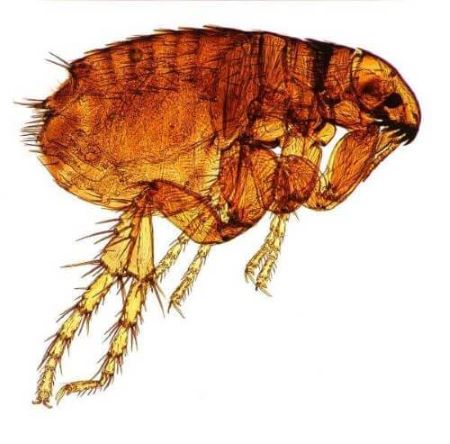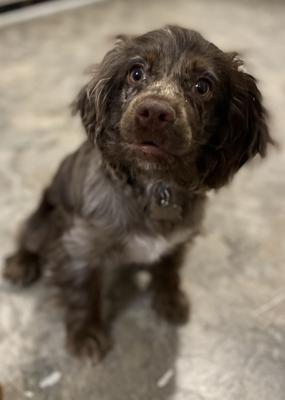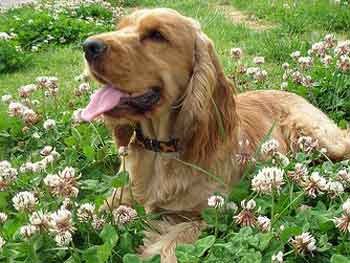- Home
- Dog Fleas and Ticks
- What Do Fleas Look Like?
What Do Fleas Look Like?
What do fleas look like? If you've never seen a dog flea, you'd be forgiven for asking that question. Even if you have seen one, fleas are so tiny and jump so quickly that it's difficult to see them in any detail.
This article describes in detail what they look like, and you'll also find a couple of gory close-ups! It also explains the tell-tale symptoms of fleas in dogs to help you keep your Cocker Spaniel free from parasites.
Squeamish? Look Away Now!
Dog fleas are tiny wingless parasites that feed on your dog's blood; however, they can also feed on humans!
 This is what a dog flea looks like - yuk!
This is what a dog flea looks like - yuk!Now you've seen this close-up, you definitely know what a dog flea looks like! What a scary little bloodsucker! It looks like something out of a horror movie, don't you think?
Just look at those hairy little legs. Who would have thought their legs would be hairy?
And what's that mouth all about?
Hopefully, you now know what a dog flea looks like.
You certainly don't want these crawling through your Cocker Spaniel's coat, never mind using your sofa or carpets as their playground!
The saying, careful what you wish for, definitely applies here!
What Do Fleas Look Like?
In reality, these blood-sucking parasites are tiny, and although they can be seen by the naked eye, you won't be able to see much detail, if at all.
They're between 1 to 4 mm long and are black or dark brown, although after feeding on your dog's blood, they swell up and turn a darker reddish-brown.
The flea's body is compressed at each side, making it very thin and flat-looking.
If you examine a flea closely, you'll see hair-like bristles on its body and legs. These bristles (and their flat, streamlined body shape) help the dog flea travel through your Cocker's coat so easily and quickly.
What Do Dog Fleas Look Like?
This YouTube video is created by KQED San Francisco.
It's a short video series called Deep Look, which takes a very close look at the dog flea, and is mesmerising, but don't take my word for it, watch it for yourself!
Dog Fleas May Be Small, But They Bite!
Dog fleas have piercing, sucking mouth parts with sword-shaped jaws that help break through your dog's skin, allowing the flea to feed on your pet's blood.
The flea's saliva contains an anticoagulant enzyme that softens the host's skin (dog or human!) to allow the flea to penetrate the skin quickly and begin to feed.
This enzyme can cause allergic reactions such as lumps, redness, and itching of the skin.
Usually, the first signs your dog has fleas will be excessive, continuous scratching, biting his skin, and nibbling at his fur. You may even catch sight of a little black speck hopping from your dog or your furniture.
Boy Can Fleas Jump!
Dog fleas may be wingless insects, but their sturdy back legs are relatively large, which helps the flea to jump distances of up to 35 cm.
That's amazing, considering its size!
Fleas don't need your Cocker Spaniel to travel around your home; all they need to do is jump to it!
They're fast and sometimes jump too quickly for the human eye to follow. However, if you manage to catch one, their polished, rigid, shiny bodies can withstand tremendous pressure making them hard to squash with your fingers, even if you are brave enough!
Although getting the flea into position is not as easy as it sounds, it can be done. You can break the shell-like body by squashing the flea between your thumbnails. (You will hear the body 'crack').
I know this to be true, as I've mastered this technique, although the occasional one may escape.
Don't forget to wash your hands with antibacterial hand wash after handling any type of parasite.
Signs Your Dog Has Fleas
You must check your dog's coat regularly to ensure he's not playing host to parasites, but do you know what dog flea symptoms to look for?
Just in case you don't, symptoms of fleas in dogs may include:
- Itching, causing your Cocker to scratch, scratch, and scratch some more!
- Red, flaking skin caused by the itching and your dog's scratching.
- He may bite or nibble at his body because his skin is itching, or he's trying to 'nibble out' the fleas.
- There may be patches of hair loss.
- You will see little dark specks in your dog's coat, close to his skin. These specks are made up of flea poop and dried blood.
- You may also see lots of little white specks; these will be the flea's eggs.
- Last but not least, a more obvious sign is seeing the adult fleas hopping on and off your dog or crawling among his coat!
The main areas to concentrate your attention on are the warm moist areas that dog fleas relish, such as the groin area, 'armpits', the base of your Cocker's tail, and his tummy. However, depending on the severity of the infestation, you could find them pretty much anywhere on your pet!
Flea Allergy Dermatitis (FAD)
Flea allergy dermatitis is an allergic reaction caused by flea saliva antigens. This saliva is injected into your pet when the flea bites before feeding on your Cocker's blood.
Not all Cocker Spaniels are allergic to the flea's saliva, but occasionally, if your dog's skin is sensitive, he may react. Symptoms of FAD are very similar to the symptoms of dog fleas.
It may seem obvious, but treatment for flea allergy dermatitis is to completely remove all fleas from your pet and home. You can learn how to do that here.
Treat your dog with a flea control product monthly; you continue until all eggs, and other flea materials have been eradicated. See the life cycle of fleas.
What Do Fleas Look Like - Question Answered?
I hope I've answered your question ("What do fleas look like?"). You should now be able to accurately identify a dog flea should your Cocker Spaniel inadvertently bring home some unwelcome guests.
You must regularly check your Cocker Spaniel's coat for signs of dog fleas.
Even if there are no signs of parasites on your dog, you should use a flea control product every month. This will deter any unwelcome hitch-hikers on your pet; you should be able to keep your Cocker Spaniel clear of fleas all year round.
For the record, there's a distinct difference between a dog flea and a dog tick; they are two entirely different parasites. Follow the link to learn about dog ticks and how to manage them.
Photo credit for 'What Do Fleas Look Like?'
Olikim at https://www.istockphoto.com/photo/dog-flea-gm172229368-2937031


